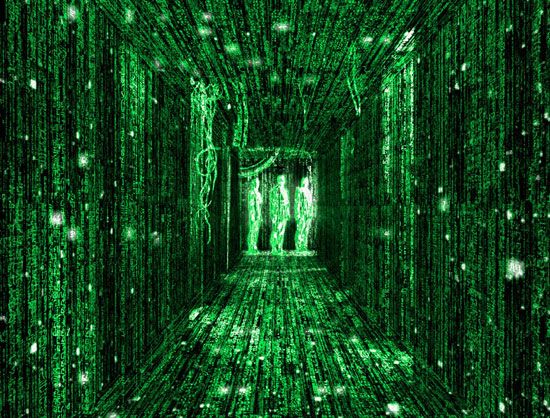The Matrix
News •
The Matrix, groundbreaking science-fiction film, released in 1999. The Matrix was written and directed by Lilly and Lana Wachowski, and it stars Keanu Reeves, Carrie-Anne Moss, Laurence Fishburne, and Hugo Weaving. The film’s innovative visual effects and seminal plot that questions the nature of reality have had a lasting influence on popular culture.
Writing and production
The Wachowski sisters first worked together as comic book writers, contributing to several different Marvel Comics series. While brainstorming ideas for their own comic, The Matrix started to form. They then made the switch to film, but it was a different script that became their first movie—Assassins (1995)—which underwent so much creative turmoil that the Wachowskis tried to have their names removed from the film credits. Despite this disappointment, they participated in several more projects while continually pitching to write and direct The Matrix. After the success of their neo-noir crime thriller Bound (1996), they got the green light for The Matrix in 1997 with a $60 million budget.
The Wachowkis’ experience in comics molded The Matrix. They worked with illustrators to create a nearly 600-page comiclike outline of the movie’s visual aesthetic to help convince film executives of the story’s viability. In the end, many of those storyboards were almost perfectly reproduced in the final cut. Working closely with the Wachowskis, comic book artist Geofrey Darrow outlined the look of the film’s postapocalyptic world with his intricate and eccentric concept art. “He draws so many details that it becomes serene. And at the same time, inside it [the drawings], every section of it, is madness,” Lana Wachowski said of Darrow’s art in the 2001 documentary The Matrix Revisited.
- Keanu Reeves (Neo/Thomas Anderson)
- Laurence Fishburne (Morpheus)
- Carrie-Anne Moss (Trinity)
- Hugo Weaving (Agent Smith)
- Gloria Foster (Oracle)
- Joe Pantoliano (Cypher)
- Marcus Chong (Tank)
- Julian Arahanga (Apoc)
- Matt Doran (Mouse)
- Belinda McClory (Switch)
- Anthony Ray Parker (Dozer)
Plot synopsis
Reeves was cast as Neo after other actors—including Brad Pitt, Will Smith, Leonardo DiCaprio, and Nicolas Cage—rejected the role. Producers also briefly considered a female star—Sandra Bullock, who had worked with Reeves in Speed (1994).
The Matrix follows software developer Thomas Anderson (Reeves), who discovers that reality is a computer simulation and enters a war between human rebels and their machine overlords. Moonlighting as a hacker under the alias Neo, he is chasing a digital mystery called the Matrix when he is approached by a woman named Trinity (Moss) who promises answers. The next day he is pursued by Agent Smith (Weaving), who captures and interrogates him. Through seemingly supernatural means, Neo’s mouth is fused shut and a robotic bug is implanted in his stomach. He wakes up the next morning and sets up a meeting with Trinity, who removes the bug and introduces him to Morpheus (Fishburne).
- Production companies: Warner Brothers, Village Roadshow Pictures, Groucho Film Partnership, and Silver Pictures
- Directors: Lana Wachowski and Lilly Wachowski
- Executive producers: Lana Wachowski, Lilly Wachowski, Bruce Berman, Andrew Mason, Barrie M. Osborne, and Erwin Stoff
- Producers: Joel Silver and Dan Cracchiolo
- Writers: Lana Wachowski and Lilly Wachowski
- Director of photography: Bill Pope
- Production designer: Owen Paterson
- Editor: Zach Staenberg
- Visual effects supervisor: John Gaeta
- Conceptual designer: Geofrey Darrow
- Visual effects: Manex Visual Effects, DFilm Services, Bullet Time, and Animal Logic
Morpheus offers Neo two pills and an ultimatum: if he takes the blue pill, Neo will wake up in his bed none the wiser; if he takes the red pill, he will uncover the Matrix, but there will be no going back. Neo chooses the red pill and is able to see the true nature of his world. Morpheus reveals that the year is about 2199. A war between humans and the artificial intelligence they created ultimately ended in the machines farming humans in pods on a massive scale, like crops, to use their body heat for energy. What humans perceive as reality is actually a simulation—the Matrix—a dream projected into the minds of the humans in their pods so that the machines can maintain control. While squidlike robots called sentinels hunt down unplugged humans in reality, the Agents are programs used to hunt down such humans when they are in the Matrix. Morpheus, who helps defend an underground refuge for free humans called Zion, then describes the prophecy of a savior whose arrival heralds the freedom of the human race. He believes Neo is this savior: the One.
After Cypher, one of the rebels, betrays the team, Morpheus is captured by the Agents in the Matrix. Trinity and Neo embark on a spectacular rescue, which ends with Neo facing Agent Smith alone. Neo is killed but is resurrected by a kiss from Trinity and defeats Agent Smith. He realizes his potential as the One and is able to see the world of the Matrix as it truly is: simple lines of code.
Impact
In one of the film’s most celebrated scenes, Reeves’s Neo bends backward on a rooftop while dodging bullets that appear to glide past him in slow motion. To capture the necessary footage, Reeves acted on a green-screen landscape surrounded by a rig of more than 120 cameras. Wires attached to Reeves’s costume pulled him downwards into an otherwise impossible backbend. Later, the “bullet time” visual effect was digitally applied to forge the iconic scene. Warner Brothers was so pleased with the film’s visuals that they increased the special effects budget.
The Matrix is a multicultural collage that was shot in Australia, based on French philosophy, features Chinese martial arts, and was influenced by American comic books. It pays homage to Alice in Wonderland (1951) and The Wizard of Oz (1939), both of which feature characters diving into fantastical worlds. The movie advances the idea of reality being a false front, which had been previously explored in films such as The Truman Show (1998) and Dark City (1998). Previous movies featured early versions of “bullet time” (a combination of photography, motion capture, and computer-generated images that creates the illusion of a subject moving in slow motion while the environment around the subject moves at a normal speed), and the exaggerated “wire fighting” (a filming technique using wires to enable actors to perform acrobatic action scenes) came from Hong Kong action movies. The Terminator (1984) covered artificial intelligence ruling over a dystopia.
With a budget of approximately $63 million, The Matrix raked in more than $460 million at the box office worldwide. It was also the first title to sell one million DVD copies, setting the record for best-selling DVD at the time. At the 2000 Academy Awards The Matrix won all four of its nominations, for best editing, best sound effects editing, best sound, and best visual effects. It became the standard against which all cinematic CGI was measured, particularly bullet time.
The Matrix is a cultural staple, extending beyond cinema. Many books dissecting different facets of the film have been published, and academic essays on the film number in the thousands. The Matrix universe includes comic books, animated shorts, and a slew of video games. It is also the source of the contemporary concept of being “red-pilled,” which describes a sudden recognition of a previously concealed, often disturbing reality. Neo chooses the red pill after Morpheus says, “You take the blue pill, the story ends. You wake up in your bed and believe whatever you want to believe. You take the red pill, you stay in Wonderland. And I show you how deep the rabbit hole goes.” The red pill has since acquired a particular social significance in alt-right communities, which use it as a metaphor to describe the process of freeing oneself from so-called liberal values.
Sequels
Three sequels followed the original 1999 film. A new character named Niobe, played by Jada Pinkett Smith, joined the cast in The Matrix Reloaded (2003). The Matrix Revolutions (2003) was released six months after the second film, and The Matrix Resurrections followed after nearly two decades in 2021; the latter was directed and cowritten by Lana Wachowski. In 2024 Warner Brothers announced that a fifth film is in the works but without either Wachowski sibling directing, although Lana Wachowski will serve as an executive producer.

















